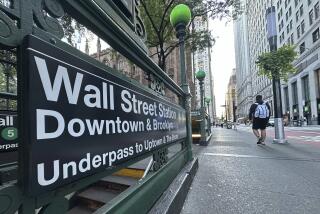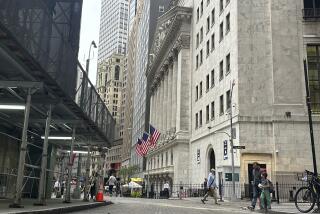THE BIG REBOUND : Wall Street’s best-known stock index has finally recouped all of its losses from the financial crisis. The market has surged as the world’s central banks have slashed interest rates to record lows, helping revive the global economy and corporate profits.
Not everyone is celebrating the new high in the Dow Jones industrial average.
After being mauled by two punishing bear markets in the last dozen years, millions of individual investors aren’t sure how to feel.
On Tuesday, the world’s best-known market gauge vaulted 125.95 points to close at 14,253.77, nearly 90 points above its previous high-water mark in late 2007.
Some small investors are dismayed at not loading up on equities when the market plunged in 2008 and early 2009. They’re aware that they may have missed their best-ever opportunity to buy low.
“I wish I’d gone in when the market crashed,” lamented John Hyche, a 53-year-old commercial banker from Pasadena.
Millions of others remain petrified of stocks after enduring punishing losses. They’ve entirely missed the bull market that has carried the Dow up 118% since its March 2009 trough.
And everyone is trying to figure out whether the bull market will continue.
Charles Chineduh, 32, a lawyer from West Los Angeles, jumped into the market in 2011 soon after graduating from law school and getting his first job.
He picked up shares in several technology and pharmaceutical companies but regrets that he couldn’t afford during law school to grab other battered stocks, such as Ford Motor Co.
“There are a lot of stocks I regret not buying,” he said. “I got in at a good time, but it wasn’t the best time.”
Many other people, however, are suffering the financial version of post-traumatic stress.
Patti Fetter, 43, of Los Angeles didn’t earn a penny when the Dow hit a new high because she didn’t have a penny in the market.
Fetter swore off stocks in 2009 after losing half her investment in the global meltdown. She also saw her boss, who was then a millionaire nearing retirement, lose a huge chunk of his savings. He’s working an additional five years to make up the difference, she said.
Even as share prices climbed steadily in recent years, Fetter, who works at an accounting firm, was too scared to venture back in.
“I don’t trust it,” she said. “I lost money. Other people lost money. I pulled it all out. I’m a single mom, so every cent is precious.”
Small investors have clearly warmed to stocks this year but not as they did before the housing bust.
Individuals have shoveled a net $54 billion into stock mutual funds so far this year after yanking almost $460 billion in the previous five years, according to the Investment Company Institute, a mutual-fund industry trade group.
But stock ownership among ordinary Americans is at a 15-year low.
The percentage of U.S. households that own stocks, either directly or through retirement accounts, fell to 45.9% last year from 53% in 2001.
And despite their new receptivity toward stocks, individuals continue to flood into bond funds. They’ve funneled in $48.5 billion so far this year after pouring in nearly $1.2 trillion in the last five years.
A few trends are clear.
Even among people who have remained in the stock market, investment strategies have changed, expectations are lower and fear is high.
Crystal Lozowchuk, an entrepreneur from Saskatchewan, Canada, dumped her stock broker in 2008 after disappointing losses. The 44-year-old decided to take greater control of her finances and has focused on buying dividend-paying stocks.
Her logic: She’ll make money even if share prices fall.
“I figure now even if my shares are a lower price I’ll still have that same income,” Lozowchuk said.
Even people who have notched big gains in the rising stock market are scared.
Michael Mehanna, a 29-year-old tax consultant from Chino Hills, “made a good chunk” by investing in Ford, Bank of America Corp. and Apple Inc. after share prices tumbled in 2008.
But he got nervous that the market would dive again and sold all his holdings a year ago to buy a house. The Dow’s new high has only intensified his fears.
“I don’t plan on investing again, not any time soon,” he said.
--
shan.li@latimes.com
--
BEGIN TEXT OF INFOBOX
Then and now
Key market and economic indicators:
Oct. 2007, --, Tuesday
4.02%, 3-month T-bill yield, 0.08%
4.65%, 10-year T-note yield, 1.90%
17.5, S&P; 500 price-to-earnings* , 14.8
3.5%, U.S. inflation rate, 1.6%
4.7%, U.S. unemployment rate, 7.9%
$206,700, Median U.S. existing home price, $173,600
3.61%, 1-year bank CD yield, 0.26%
$737, Gold (ounce), $1,575
$80, U.S. oil (barrel), $91
95.2, U.S. consumer confidence index, 69.6
Sources: Standard & Poor’s, Bankrate.com, Bloomberg News
* P/E on last four quarters’ earnings
----
Oct. 9, 2007
14,164.53
The Dow Jones industrial average peaks and begins descent amid growing signs of trouble in housing market.
Note: Chart reflects monthly closes and selected dates.
March 14, 2008
11,951.09
Bear Stearns is unloaded in fire sale to JPMorgan.
Sept. 15, 2008
10,917.51
Lehman Bros. collapses; Merrill Lynch forced to sell to BofA.
Oct. 3, 2008
10,325.38
Congress approves $700-billion banking system rescue.
Dec. 16, 2008
8,924.14
Fed cuts key interest rate to zero.
March 9, 2009
6,547.05
Market hits low amid rumors of bank nationalization.
May 6, 2010
10,520.30
Market “flash crash”
July 21, 2010
10,120.53
President Obama signs Dodd-Frank financial system reform law.
Nov. 3, 2010
11,215.10
Fed boosts bond purchases (“QE”).
Aug. 5, 2011
11,444.61
S&P; downgrades U.S. credit rating.
July 26, 2012
12,887.90
ECB Chief Mario Draghi says he will do “whatever it takes” to save euro.
March 5, 2013
14,253.77
Dow closes at a record high on hopes for economy.
More to Read
Inside the business of entertainment
The Wide Shot brings you news, analysis and insights on everything from streaming wars to production — and what it all means for the future.
You may occasionally receive promotional content from the Los Angeles Times.











